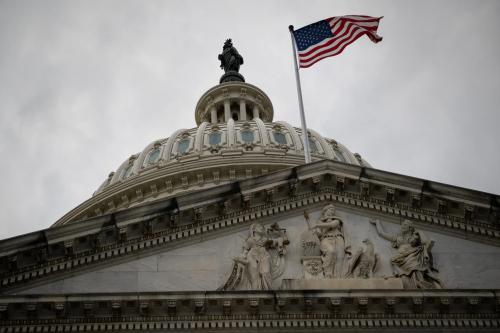In Michigan in 2022, a woman named Tirany Savage filed for a protective order against her husband Bo Eugene Savage and asked that he be removed from their house. She informed the court that her husband “has mental health issues (he quit taking his meds) and recently purchased a firearm & that is concerning to me. He keeps saying he is going to blow his brains out and I do not want my safety or my son’s safety in jeopardy.” The time after a request for a DVRO is made can be the most dangerous phase for victims of domestic violence, but the judge denied the order and sent the woman to divorce court, where she filed for divorce and asked for the protective order. Just a few days later, Tirany Savage, her mother, and her 13-year-old son were shot to death by Bo Savage, who then shot himself.
This case is illustrative of why, nearly thirty years ago, federal law prohibited individuals subject to domestic violence restraining orders (DVROs) from possessing a firearm. The original provisions were passed in the Violence Against Women Act (VAWA) in 1994. Two years later, Congress passed the Lautenberg Amendment which prevents DV misdemeanants from purchasing or possessing a firearm. Together, these two bills are foundational in terms of setting forth federal policy on domestic violence and especially the ownership and possession of firearms by individuals who are convicted of domestic abuse.
Since then, there has been an uneven response by state governments to these laws; 28 states have enacted Domestic Violence Firearm Laws (DVFLs) to mirror the provisions of the Lautenberg Amendment, but the other states have not done so. On a range of laws that would limit gun ownership to these individuals, states have differed in the protections they offer to domestic violence victims.
In our new book, Inequality Across State Lines: How Policymakers Have Failed Domestic Violence Victims in the United States (Cambridge University Press 2023), we trace the history of these domestic violence firearm laws (DVFLs) and show how state and federal action in the area of domestic violence policy has created different levels of human security for women in the United States. Our research, which spans 1990-2017, finds that these laws are most likely to be enacted in states in response to rates of gun homicides and the initial passage of federal laws on domestic violence. Politically, DVFLs have passed in states where citizens are more liberal, and they are less likely to be passed in states that are under unified Republican Party control or during a state legislative election year. Despite increased public attention to gun violence in America, we show how the momentum for these laws has been slowed by increased polarization and partisanship surrounding gun control, as well as the active opposition to these laws from the National Rifle Association and other Second Amendment rights groups.
Federal and state laws affecting gun ownership are paramount in reducing domestic violence related female homicides. The presence of a firearm in a domestic violence situation increases the risk of homicide by 1000%. The CDC has reported that 9,450 women died from domestic violence incidents between 2003 and 2017, with nearly half of those homicides committed with a firearm. Research has shown that DVFLs reduce domestic violence homicide by upwards of 14%. Put simply these laws are necessary and work to save women from paying the ultimate price of their lives from domestic abuse.
Until now, the Supreme Court has been a relative haven for federal domestic violence firearm laws, with support from liberal and conservative judges alike. In three major cases, United States v. Hayes (2009), United States v. Castleman (2014), and Voisine v. United States (2016), the Court affirmed the scope of these laws. However, for the first time since the DVRO limitation on gun possession was enacted, its basic constitutionality is in question. On February 2, 2023, the 5th Circuit Court of Appeals released its decision in the case United States v. Rahimi. The decision begins with the following statement: “The question presented in this case is not whether prohibiting the possession of firearms by someone subject to a domestic violence restraining order is a laudable policy goal. The question is whether 18 U.S.C. § 922(g)(8), a specific statute that does so, is constitutional under the United States Constitution.” In a stunning reversal of nearly 30 years of federal law, the 5th Circuit questioned the legitimacy of federal governmental, and by extension state governmental, efforts to protect women from gun violence at the hands of their abusers.
The Rahimi decision is directly related to the Supreme Court decision in New York State Rifle & Pistol Association v. Bruen (2022) which altered the way judges evaluate firearm laws. In a majority opinion written by Clarence Thomas, the court ruled that firearm laws must be assessed via “historical inquiry.” This means judges must consider whether a firearm law of today would have been acceptable or even plausible at the time the Constitution was ratified. The 5th Circuit ruled that there was no historical support for removing firearm access from domestic abusers. On its face, rejecting a domestic violence firearm law on historical precedent from an era where women did not even have the right vote and “wife beating” was still legal in the colonies simply does not make sense. Maryland was the first state to pass a law criminalizing wife-beating in 1882, nearly a century after the ratification of the U.S. Constitution. It took another hundred years for the federal government to pass its first family violence law dedicating money to emergency shelters and domestic violence coalitions. Today, in the 21st century, women, their children, and families will pay the price for enforcing 18th century views on Second Amendment rights if the Supreme Court upholds the Rahimi decision.
The decision by the 5th Circuit reminds us of the very powerful role that the judicial system plays in implementing domestic violence laws. In dealing with law enforcement, prosecutors, defense attorneys, and judges, victims and abusers navigate a complex environment which is made even more challenging because of variation in state laws on gun ownership. In many states, judges are prohibited from ordering the surrender of a firearm or issuing a warrant to remove a firearm from an abuser, unless the abuser has actively used it to threaten their victim. Moreover, the abuser must be informed that they cannot possess a firearm under the conditions of a protective order, but in some cases, there is no follow up by court officers or the abuser is not easily located. These dangers to domestic violence victims are compounded by shared custody agreements, or bail conditions, that do not require the surrender of firearms.
The intentions of both the Violence Against Women Act and the Lautenberg Amendment were to drive home the lethality of the interaction of firearms with domestic violence, and to encourage states to adopt policies and practices that prevent such violence. But a number of state legislatures leave it entirely to the judge’s discretion to issue a protective order and add or omit gun restrictions therein; in some cases, a judge makes a decision that turns out to be fatally wrong, as we saw with the Savage case discussed above.
What happened to the Savage family in Michigan in the summer of 2022 is a far too frequent occurrence in America because the federal government leaves enforcement of DVFLs to state governments and to local judges; in this way federalism creates variation in a woman’s human security depending upon where she lives. Federalism itself is a problem in effective policy implementation in the arena of domestic violence. It is difficult enough to keep women safe when some judges refuse to use their power to remove firearms from abusers. If the Supreme Court eviscerates federal and state governments’ authority to include firearm prohibitions in DVROs completely, they will remove a key source of protection against domestic violence deaths, and like Tirany Savage, more women will lose their lives at the hands of their abusers.
For resources for domestic violence in the United States visit the National Coalition Against Domestic Violence at www.ncadv.org and the National Domestic Violence Hotline at www.thehotline.org
The Brookings Institution is committed to quality, independence, and impact.
We are supported by a diverse array of funders. In line with our values and policies, each Brookings publication represents the sole views of its author(s).









Commentary
Can government protect women from domestic violence? Not if states do not follow up.
March 21, 2023